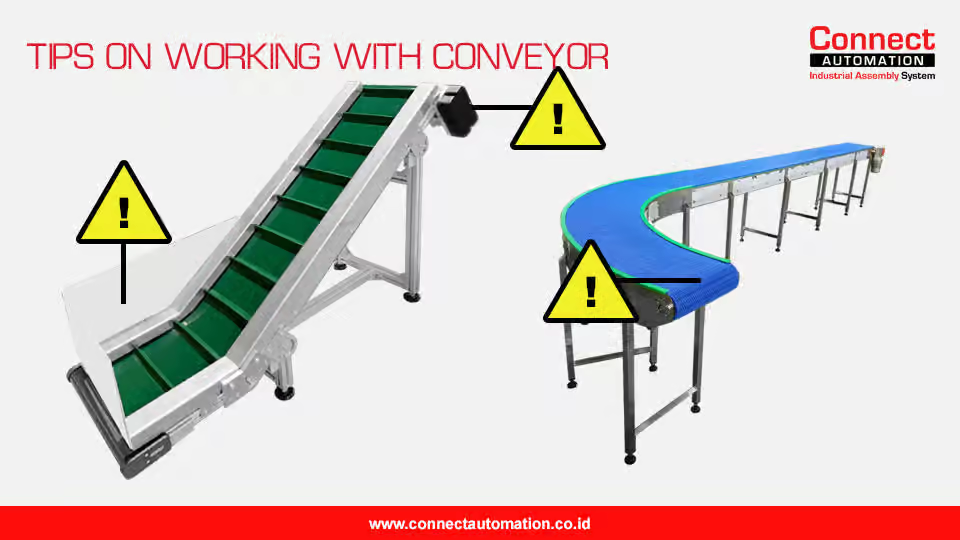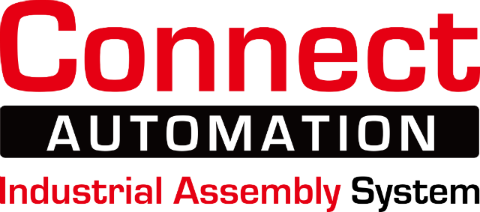REQUEST A FREE ESTIMATE!
Tips On Working Safely With Conveyor

Belt conveyors have the most crucial role in any industries’ production line. The crucial role of a conveyor is to replace human resource required when moving products in a large quantity repeatedly. With human resource, product transfer can only be done in a cyclic manner because several people (even with aiding tools) have limits on how many they can carry for one trip. By using conveyor, not only the job of moving products goes to conveyor but it can also move large quantity of products continuously.
Conveyor have many secondary roles in the many fields of industry. In packaging industries for example, conveyor can be used to move packaging goods from cutting machines to labelling area. In food industries, conveyor can be used to transfer processed goods from oven machine to cooling area (conveyor can also be used to support the cooling process).
Here are several tips that can be done to minimalize work accidents around conveyor.
-
Use safety shoes and hard hat
If the surface of the conveyor is higher then people’s foot and the objects on top of conveyor have risks of falling, then it is recommended to use safety shoes to protect people’s foot from injury. If the surface of a conveyor or the products moved by the conveyor is higher or equal to the height of people’s head, then always use a hard hat to protect your head from any objects thrown off of a conveyor
-
Make sure you don’t have any lengthy objects which movement can’t be controlled
Things such as key rings, necklace and even long hair are risks that needs to be handled before working around conveyor. These lengthy objects can get snagged in any moving parts of a conveyor, pull worker and risks worker that are working near conveyor to be injured. Always keep things that are not necessary while working near a conveyor, follow common dress code rules, and use hair net if you have long hair.
-
Always know the location of emergency button
If feared risks do happens, then you need to move quickly to press the emergency button or have someone else near it to press it so the conveyor would stop running and your emergency situation can be resolved. Always make sure that the emergency button is fully operational before running a conveyor.
-
Make sure that safety guards / guardings are installed
Incorrectly maintained and operated conveyors can causes malfunction or short-circuit which leads to fire. To avoid injuries to worker when this happens, it is recommended to install safety guards / guarding panels around any parts of conveyor that are potentially hazardous.
-
Always follow Lock-Out, Tag-Out procedure
Conveyors are just like any other machines that require periodic maintenance. Before doing any maintenance processes, always powered down and secure conveyor’s power source by locking (Lock-Out) the power source and telling (Tag-Out) everyone else about the upcoming maintenance so other workers does not accidentally powered on the conveyor while you are still maintaining it.
These are several things you must not do when working near a conveyor.
-
Do not wear any jewellries and loose clothing
Jewellries and loose clothing (including an untucked shirt) have the potential to be snagged in conveyor’s moving parts and would leads to worker’s injury. Even long hair have the potential of getting snagged and therefore should be tied or put into a hair net.
-
Do not sit or stand on top of conveyor
Conveyor commonly supports weight around 70kg and even above 70kg if stronger material is used, but it doesn’t mean that workers are allowed to sit, ride or climb on top of the conveyor. Doing these things could cause the conveyor to roll over and you fall. Doing it on a runninig conveyor will further increase the risks of you (or your clothes) getting snagged in the conveyor.
-
Do not alter conveyor’s safety mechanism
Conveyor’s safety mechanisms are installed for one purpose which is to mitigate and avoid any work accident when operating a conveyor.
-
Do not try to pull out snagged object before the conveyor is powered down
If there are any objects got snagged in the conveyor or if there is any maintenance to be initiated, make sure you follow LOTO (Lock-Out, Tag-Out) procedure before pulling out the snagged object, so you are evaded of any risks of you getting snagged too.
-
Do not turn your back from a conveyor
Make sure you always have the conveyor and any products on top of it in your sight when working near the conveyor. This enables you to always see whatever happens on top of the conveyor so when there are objects thrown off from the conveyor to your direction, you have the ability to do evasive maneuver.
Connect Automation specializes in providing automation solutions, including conveyor systems, to improve efficiency across various industries. The company delivers cutting-edge technology to help organizations automate tasks and optimize workflows. Connect Automation helps businesses reduce manual efforts, boost productivity, and achieve better outcomes. With a customer-focused approach, the company designs tailored solutions to ensure smooth and effective automation transitions for long-term success.
Kawasan Industri Jababeka Tahap 1, Jl. Jababeka II D Blok C14L Cikarang, Indonesia (17530)
(021) 893 5060 Google Maps
Rungkut Industri III, No. 37, Rungkut Menanggal, Kec. Gn. Anyar Surabaya, Indonesia (60293)
(031) 9985 8624 Google Maps
